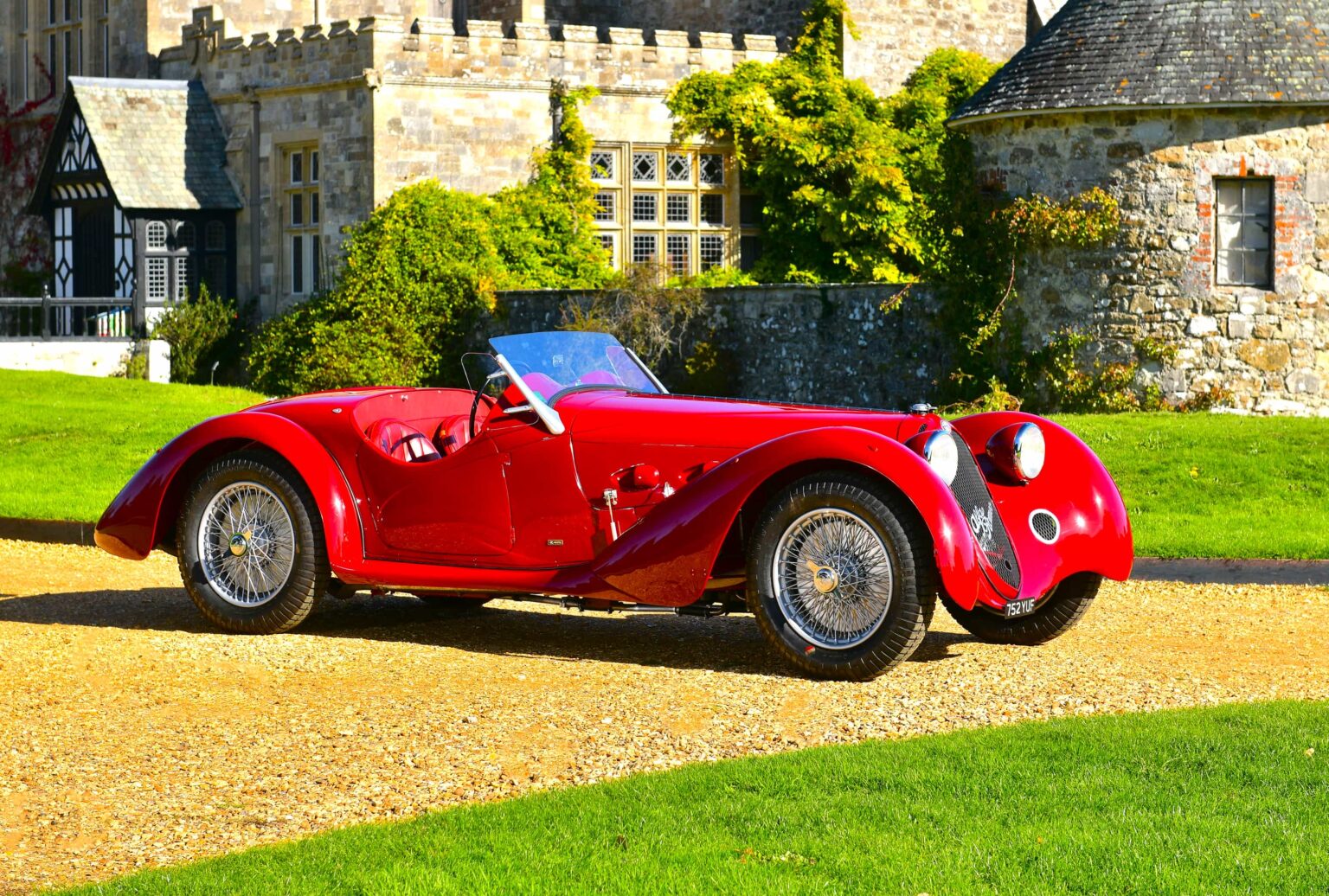A pre-war supercar dubbed the most important ever made – has been sold for over £2.8m.
The 88-year-old historic Alfa Romeo is one of just a handful known to exist.
Just 38 were ever made, and fewer survive today.
READ MORE: Iconic Ferrari F40 owned and signed by F1 legend Alain Prost hits market for £2.75m
- Advertisement -
The 8C 2900 B Spider in the style of Zagato was made in 1937.
Fascist dictator, Benito Mussolini, was the leader of Italy at the time.

He was an admirer of Alfa Romeo and owned several.
The 8C 2900 B Spider was described as an engineering masterpiece powered by a Grand Prix-derived, twin-supercharged, 2,905-cc eight-cylinder engine.
And as arguably the most important model in Alfa Romeo’s long and storied history.
- Advertisement -
It was the first road car made using an engine, brakes and a lightweight chassis developed in motor racing, as reported by Whats The Jam.
Ahead of its sale its listing said: “Many cars claim to benefit from motorsport technology, but few can assert such a direct link as Alfa Romeo’s 8C 2900 B.
“Only Alfa Romeo’s monoposto cars could provide any resistance to Germany’s Silver Arrows during the mid-1930s but none of the racing creations from Stuttgart nor Zwickau yielded any technology that transitioned to application onto the public road.
- Advertisement -

“With the 2900, it was an entirely different approach, with a relatively lightweight chassis featuring fully independent suspension and large drum brakes, all of which had been developed on the race circuit.
“The masterpiece of the car was its engine, which was derived directly from the legendary 1934 Tipo B, also known as the P3, which featured a 2,905 cc double overhead-cam engine with twin superchargers forcing air and fuel into an eight-cylinder layout.
“Only 38 examples of the 2900 were produced by Alfa Romeo, with fewer known to exist today.
“Some of the most desirable of these are the long chassis Spiders – long being a relative term as the wheelbase was only extended by 20 centimetres, but provided the most luxurious platform for a two-seater body.
“Built in 1937, chassis number 412011 was first owned by Ernst Carstens, who ran his family’s eponymous ceramics business in Elmshorn, north of Hamburg, Germany.

“As foreign-built cars were not seen as patriotic at the time, it is believed that the Karosseriewerk Aug Nowack was commissioned to build a two-seat Cabriolet body that had a strong likeness to Erdmann and Rossi bodies fitted to Horch roadsters.
“In January 1938, it was back at the factory, complete with its Nowack coachwork and weighing in at 1,462 kilograms, which would indicate that it was built as a desirable Lungo chassis from new.
“It was later photographed at the Portello factory in March 1938.
“The car returned to Alfa Romeo in November 1938 for servicing, and then little is known of its history during the war.
“There is a chance that this wonderful Alfa Romeo remained in the care of the Carstens during the war, as it was then photographed with pre-1956 British Zone Hamburg plates at the Nürburgring in 1951.
“By 1952, it was reportedly owned by a film studio in Darmstadt, which sold it to David Holtorf, an American serving in the US Air Force in West Germany.

“By this point, it had lost its 2900 engine and was now fitted with a 6C 2500 unit.
“Holtorf had 412011 shipped to New York before driving it home to Valparaiso, Indiana, a stone’s throw from Chicago.
“A lack of funds to maintain the Alfa Romeo meant it was sold on.
“It then went through several hands in the Chicago area before being owned by Paul Schreiber, who commenced a restoration that soon turned out to be beyond his skill set, but Schreiber had located a number of 2900 engine components.
“Bill Knauz then bravely took on the project and wrote to Simon Moore in May 1969, updating him on progress.

“Moore inspected this 8C in 1971, by which time the chassis was restored, but building a complete engine remained an elusive goal.
“In May 1978, it returned to Europe and was sold to Massimo Colombo, an Italian dealer, who managed to acquire a couple of correct Roots superchargers before it was purchased by David Cohen.
“In the early 1980s, chassis 412011 joined the collection of esteemed Alfa Romeo authority and restorer David Black.
“The understanding of the car at the time was that the Nowack Cabriolet body was not the original and the chassis had been lengthened to fit the body—both points which are now known to be incorrect.
“Black wished to return the car to a form that he believed it was originally, a short chassis with a sporting Spider body.
“An appropriate body became available during the restoration of an 8C 2300—this body was commissioned by racer and dealer Felice Bonetto in the late-1930s and is rumoured to have been completed by Zagato for the Brussels Motor Show.

“Black’s restoration of chassis 412011 was halted by his passing before it recommenced with the help of Jim Stokes, Bill Summers, and Keith Roach.
“Following completion in the late 2000s, this pre-war supercar has been actively campaigned by the Black family at VSCC events in the UK.
“In July 2025, the Alfa Romeo received significant maintenance from Jim Stokes Workshops Ltd, concluding in a painstaking engine rebuild, with the invoice available to view on file.
“Importantly, this significant 2900 B retains a large number of original numbered components throughout, such as its engine crankcase (believed to originate from chassis 412027), confirmed upon inspection by Jim Stokes Workshops, who also confirmed that the current engine block is numbered 422031.
“The engine plate has a number ‘6’ stamped over the engine number’s final ‘1’, but the opposite leg shows the original ‘422031’ stamping.
“The Alfa Romeo has retained its extremely rare Electron magnesium alloy gearbox/differential housing, something usually seen on Works racing cars.
“In recent months, the engine has been fully rebuilt by Jim Stokes Workshops, along with other servicing work.

“Notably, the original Nowack body accompanies the car, allowing any future owner to return it to its first state.
“Any 8C 2900 can be rightly regarded as magnificent.
“The inclusion of one of the 38 into a collection elevates the stable to global prominence, not simply for its rarity or status but rather its position as an engineering masterpiece from one of the most luxurious eras.
“Chassis 412011 will always be a significant example as the only example to be bodied in Germany when new.
“Offered after four decades of enthusiastic family ownership, this 8C is a prime contender for entry into driving events, displayed on the Concours circuit, or returned to its original state.
“This beautiful Grand Prix-engined, pre-war supercar will afford its next owner countless opportunities and experiences as the next chapter of its story begins.”
It went under the hammer with RM Sotheby’s in Belgravia, west London, on Saturday, (1 Nov) and sold for £2,817,500.
It has been expected to sell for up to £5.5m.
READ MORE: 90-year-old golf simulator heading under the hammer for £4,000… but there’s a catch


















